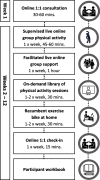Co-creation of a complex, multicomponent rehabilitation intervention and feasibility trial protocol for the PostUraL tachycardia Syndrome Exercise (PULSE) study
- PMID: 37582801
- PMCID: PMC10426060
- DOI: 10.1186/s40814-023-01365-4
Co-creation of a complex, multicomponent rehabilitation intervention and feasibility trial protocol for the PostUraL tachycardia Syndrome Exercise (PULSE) study
Abstract
Background: There is a dearth of research to support the treatment of people with postural tachycardia syndrome (PoTS). Despite expert consensus suggesting exercise is recommended for this patient group, there are no randomised control trials examining this rigorously. The aim was to co-create a feasibility trial protocol and a rehabilitation intervention for people living with PoTS.
Methods: The intervention and feasibility trial design were co-created as part of the PostUraL tachycardia Syndrome Exercise (PULSE) study. We used the 'three co's framework' of co-define, co-design and co-refine. Recruitment included key national charities and National Health Service Trusts treating people living with PoTS in the UK. Eighteen patient and public involvement members attended the co-define session, and 16 co-creators with a mix of expertise attended the subsequent co-design and co-refine sessions. Seven intervention practitioners were trained in the rehabilitation intervention, providing feedback for further co-refinement.
Results: The final co-created intervention comprises online physical activity, and lifestyle and behaviour change support sessions. It is based on functional movement activities using a patient-centred approach tailored to individual needs. Physical activity intensity is guided by individuals' perception of effort rather than by objective measures. Recumbent bikes are provided for home use. Patients deemed randomisation to be acceptable because research in this area was considered important.
Conclusions: An innovative approach was used to co-create the PULSE intervention and feasibility trial protocol to meet the evidence-based and logistical needs of people living with PoTS, clinicians, service deliverers, third-sector organisations, academics and funders. This can be used as a successful example and template for future research internationally. People living with PoTS were recognised as experts and involved in every aspect of conceptualisation, design and refinement. This complex rehabilitation intervention is currently being tested in a randomised feasibility trial comparing the PULSE intervention with best-practice usual care for people living with PoTS.
Trial registration: ISRCTN45323485 was registered on April 7, 2020.
Keywords: Cardiac rehabilitation; Co-creation; Co-production; Dysautonomia; Exercise; Feasibility randomised controlled trial; Intervention development; Patient and public involvement; Physical activity; Postural tachycardia syndrome.
© 2023. BioMed Central Ltd., part of Springer Nature.
Conflict of interest statement
GP, NH, HE, JB, ET, LA, JS, RE, PM, RP and SK declare that they have no competing interests.
HS is the director of Health Psychology Services Ltd., providing psychological services for a range of health-related conditions.
LK is the Trustee and chair of PoTS UK. She has received funds from NHSE, Medtronic, Cogora and Badger to deliver educational events, talks and materials about PoTS and syncope.
GM is a director of Atrium Health Ltd., a provider of rehabilitation services for the National Health Service.
Figures



Similar articles
-
Protocol update for a randomised controlled feasibility trial of exercise rehabilitation for people with postural tachycardia syndrome: the PULSE study.Pilot Feasibility Stud. 2022 May 7;8(1):101. doi: 10.1186/s40814-022-01056-6. Pilot Feasibility Stud. 2022. PMID: 35525992 Free PMC article.
-
Protocol for a randomised controlled feasibility trial of exercise rehabilitation for people with postural tachycardia syndrome: the PULSE study.Pilot Feasibility Stud. 2020 Oct 19;6:157. doi: 10.1186/s40814-020-00702-1. eCollection 2020. Pilot Feasibility Stud. 2020. PMID: 33083000 Free PMC article.
-
A modified video-feedback intervention for carers of foster children aged 6 years and under with reactive attachment disorder: a feasibility study and pilot RCT.Health Technol Assess. 2022 Aug;26(35):1-106. doi: 10.3310/SLIZ1119. Health Technol Assess. 2022. PMID: 35959710 Free PMC article. Clinical Trial.
-
Behavioural modification interventions for medically unexplained symptoms in primary care: systematic reviews and economic evaluation.Health Technol Assess. 2020 Sep;24(46):1-490. doi: 10.3310/hta24460. Health Technol Assess. 2020. PMID: 32975190 Free PMC article.
-
Cue-based versus scheduled feeding for preterm infants transitioning from tube to oral feeding: the Cubs mixed-methods feasibility study.Health Technol Assess. 2021 Dec;25(74):1-146. doi: 10.3310/hta25740. Health Technol Assess. 2021. PMID: 34878383
Cited by
-
Exercise rehabilitation for people with postural tachycardia syndrome at two secondary care centres in the UK: the PULSE feasibility randomised controlled trial.BMJ Open. 2025 Feb 22;15(2):e090197. doi: 10.1136/bmjopen-2024-090197. BMJ Open. 2025. PMID: 39987007 Free PMC article. Clinical Trial.
-
Co-Created Solutions for Perinatal Professionals and Childbearing Needs for People with Hypermobile Ehlers-Danlos Syndrome and Hypermobility Spectrum Disorders.Int J Environ Res Public Health. 2023 Oct 21;20(20):6955. doi: 10.3390/ijerph20206955. Int J Environ Res Public Health. 2023. PMID: 37887694 Free PMC article.
-
Editorial: Designing and evaluating digital health interventions.Front Digit Health. 2025 May 8;7:1612380. doi: 10.3389/fdgth.2025.1612380. eCollection 2025. Front Digit Health. 2025. PMID: 40405909 Free PMC article. No abstract available.
-
Exercise Interventions in the Management of Postural Orthostatic Tachycardia Syndrome: A Scoping Review.J Multidiscip Healthc. 2024 Dec 9;17:5867-5885. doi: 10.2147/JMDH.S495088. eCollection 2024. J Multidiscip Healthc. 2024. PMID: 39678714 Free PMC article.
References
-
- Raj SR, Guzman JC, Harvey P, Richer L, Schondorf R, Seifer C, et al. Canadian cardiovascular society position statement on postural orthostatic tachycardia syndrome (POTS) and related disorders of chronic orthostatic intolerance. Can J Cardiol. 2020;36(3):357–372. - PubMed
-
- Benrud-Larson L, Dewar MS, Sandroni P, Rummans TA, Haythornthwaite JA, Low PA. Quality of life in patients with postural tachycardia syndrome. Mayo Clin Proc. 2002;77(6):531–537. - PubMed
Grants and funding
LinkOut - more resources
Full Text Sources
Miscellaneous

